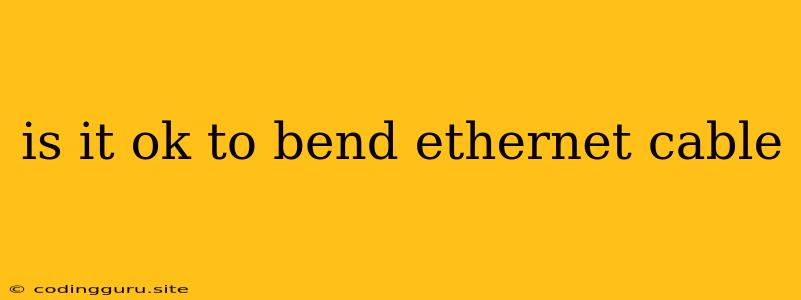Is It OK to Bend Ethernet Cable?
The question of whether or not it's okay to bend an Ethernet cable is a common one, especially for those who are setting up their home networks or working with computer systems. The answer, while not entirely straightforward, is generally no, you should avoid excessively bending Ethernet cables.
Here's why:
Understanding Ethernet Cable Construction
Ethernet cables are made up of a core of copper wires encased in a protective sheath. This sheath is often made of PVC or a similar material. The internal structure of the cable varies depending on the type of cable (Cat5, Cat6, etc.), but the principle remains the same: the wires are designed to carry electrical signals.
The Impact of Bending
When you bend an Ethernet cable, you're putting stress on the copper wires within. This stress can:
- Damage the wires: Excessive bending can cause the copper wires to break, creating a discontinuity in the signal path. This can lead to a loss of connection or a degradation of the signal quality.
- Affect the insulation: Bending can also damage the insulation around the wires, leading to short circuits. This can potentially damage your network devices or create a fire hazard.
- Compress the cable's internal components: If you bend the cable too sharply or repeatedly, you risk compressing the internal components, further impacting signal quality and potentially causing damage.
What Does "Excessive Bending" Mean?
It's not that bending an Ethernet cable is inherently bad. A slight bend is unavoidable when routing the cable around furniture or through tight spaces. However, avoiding sharp bends, kinking, or repeated bending is crucial.
Practical Tips for Handling Ethernet Cables:
- Use cable ties: Securely manage your Ethernet cables using cable ties to avoid tangling and excessive bending.
- Use cable clips: Install cable clips along walls or on desks to keep the cables organized and prevent them from being bent excessively.
- Avoid tight corners: Try to route your cables through wider curves rather than sharp corners.
- Use cable sleeves: Protect your cables from wear and tear by using cable sleeves, especially in high-traffic areas.
- Consider using fiber optic cables: While more expensive, fiber optic cables are much more resistant to bending and generally offer better performance.
Signs of Damage
If you suspect your Ethernet cable may be damaged due to bending, look for the following signs:
- Intermittent connection: You may experience frequent connection drops or a slow internet connection.
- Distorted audio/video: If using the cable for audio or video, you might notice crackling or pixelation.
- Physical damage: Look for visible signs of damage to the cable, such as cuts, kinks, or broken wires.
Testing and Replacement
If you suspect your Ethernet cable is damaged, try testing it with a different cable or connecting to a different port on your router or switch. If the problem persists, then replacing the cable is likely necessary.
Conclusion
While bending Ethernet cables is unavoidable in some cases, it's essential to be mindful of how you handle them. Avoid sharp bends, kinking, and excessive bending to ensure your cables remain functional and your network runs smoothly. By following these tips, you can maximize the lifespan of your Ethernet cables and minimize the risk of connectivity issues.
